How to propagate aloe at home?
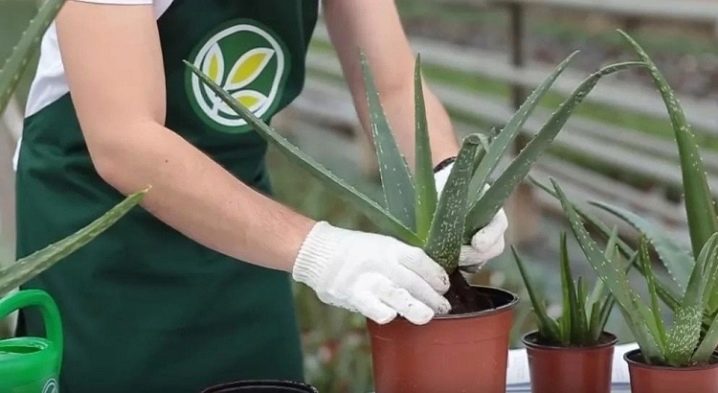
Aloe, or as it is often called, the agave, is a plant that is usually grown for its unique healing qualities, and not because of its beauty and original appearance. Since the flower is indispensable in the treatment of many diseases and is often used for cosmetic purposes, there is a need for more than one plant. Therefore, it is so important to know how to reproduce it correctly.
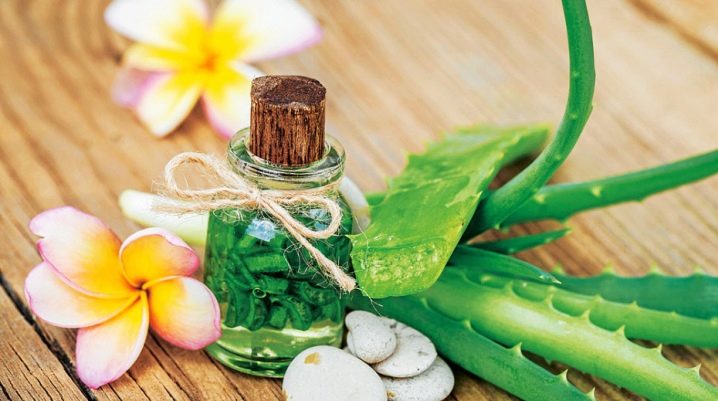
The best time
You can successfully propagate aloe at home if you know some of the necessary nuances. One such factor is the time that is best for it to breed. Reproduction is feasible in any season, but a particularly favorable time is the spring and first summer months.
At this time, active vegetative development of aloe begins, guaranteeing the fastest and most active root growth in the shoots. In other months, reproduction is also possible when the necessary temperature regime is created, but the rooting process may be somewhat delayed.
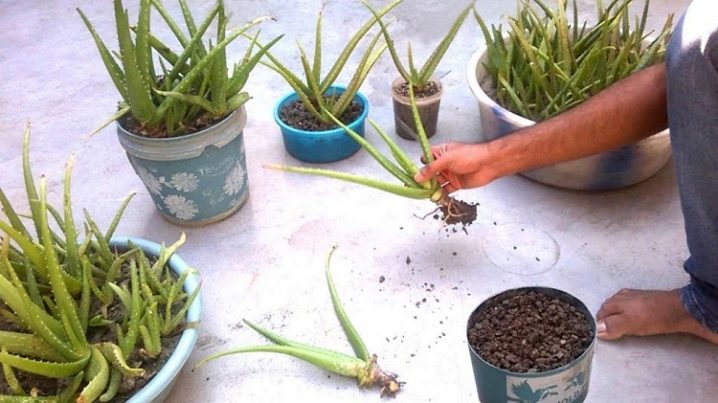
Soil requirements
Aloe is a plant in those southern latitudes where the climate is very hot and precipitation is infrequent. The plant grows in dry, marginal, sandy or clayey lands. For successful indoor cultivation, he needs to create similar conditions.
The success of growing agave depends to a large extent on the correct composition of the soil, since a root system develops in it, which affects the further development of the plant as a whole. Aloe leaves turn yellow from improperly selected soil, and the flower itself may subsequently die.
Agave soil must meet several requirements.
- Have good air and moisture permeabilitywithout delaying her. To achieve looseness of the soil, it is necessary to add loosening components to it - sand (preferably coarse), gravel, small pebbles, perlite, pieces of charcoal.
- The soil must be slightly acidic (ph 6.5-7), neutral is also acceptable.
- The soil composition should contain a sufficient amount of iron.
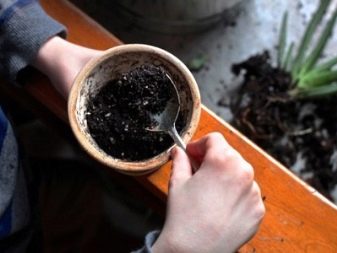

Usually they use ready-made soil designed specifically for succulents. It contains all the elements necessary for the full growth of aloe. You can make your own potting mix. Its components can be:
- turf, deciduous or garden soil - 2 parts;
- humus, sand - one piece at a time.
Be sure to add fine gravel (it will give looseness to the soil) and charcoal powder. Wood ash is taken at the rate of 50 g per liter of substrate. It is not recommended to include peat in the potting mix.
Before planting the plant itself, the substrate is additionally subjected to heat treatment in the oven (about 30 minutes) or watered with a slightly pink solution of potassium permanganate.

Leaf breeding
There are many methods of propagation of aloe, which differ in the length and complexity of the process. But it is the variety that allows you to choose the most acceptable way of breeding the agave. Leaf propagation is one of them. This method is usually used when it is necessary to rejuvenate an aged flower in order to give it a stimulus to develop.
You need to choose only a well-developed strong healthy leaf at least 8 cm in size. Then the actions are carried out in a certain order.
- The leaves should be cut with a clean and sharp tool from the very base of the stem.The cut should be oblique.
- Cut leaves, placed on a dry cloth (bandage, gauze, cotton napkin), should be left for 1-2 days in a dark room. The cut should dry out and be covered with a film.
- The dried cut is sprinkled with charcoal powder (activated carbon can be used).
- Next, a soil mixture is prepared from garden soil, sand and vermiculite, which is placed in a container and moistened.
- The leaves must be planted in the soil mixture, deepening them by about 3 cm.
- The container with leaves is placed in a fairly light and warm room.
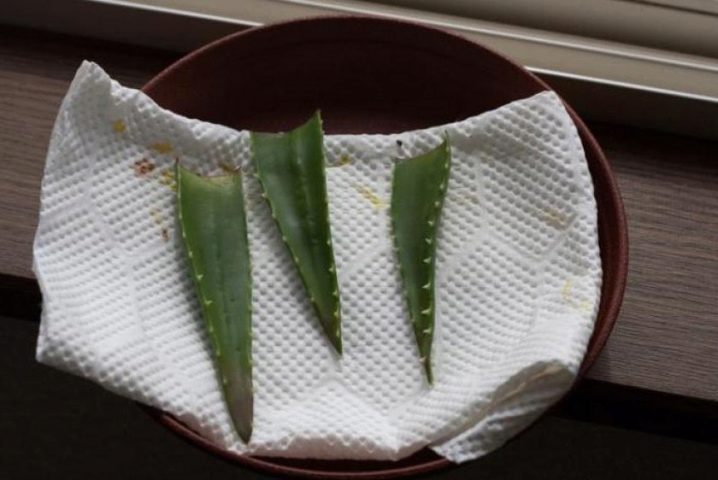
You can also not drop the leaves: they are simply laid out on the surface of the soil. The roots that appear later will themselves go into the soil. The planted leaves must be watered regularly (every day) and abundant.
After the roots appear, the leaves will begin to grow, and young seedlings can be planted in separate bowls.

How to plant seeds?
You can also breed aloe with seeds, but this method is more time-consuming and requires more work. But it allows you to breed many plants at once, and the number of established seedlings is much higher than when using other methods.
Under natural conditions, aloe blooms quite regularly. Its flower is a panicle on a long stem or a cluster of inflorescences.
But since aloe blooms very rarely when grown indoors, the seeds can be bought in specialized flower shops.
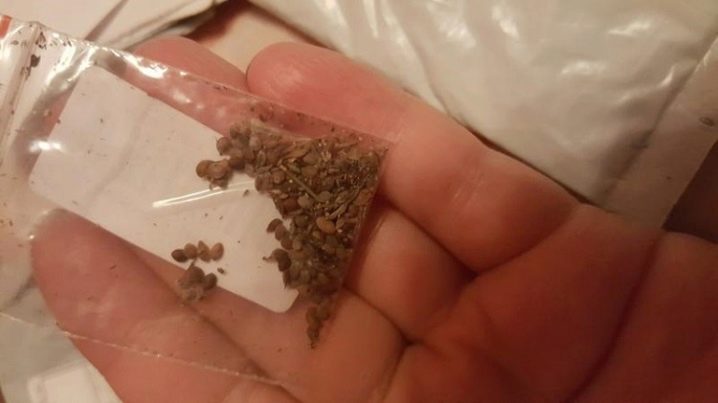
The best time for sowing seeds is the last days of February - the first decade of March. The germination container should be low and flat. Seeds are planted in the following sequence:
- first, you need to pick up the soil - ready-made or prepare at home (turf or leafy land with sand in equal proportions);
- the soil mixture is placed in the container, moistened, and then the seeds are sown to a depth of no more than 3 cm with an interval of one and a half centimeters;
- in order to germinate seeds faster, the container is covered with polyethylene, thus creating a mini-greenhouse;
- until shoots appear, it is necessary to keep the seeds at a temperature of within +22 degrees, to maintain the moisture content of the soil and prevent it from drying out;
- then the film is removed, and watering is carried out as needed and only with the help of a spray bottle;
- picking seedlings into separate bowls should be carried out as soon as 2-4 real young leaves appear, using the same substrate.
A year later, the young flower needs to be transplanted again into a more spacious bowl. With this method of reproduction, it is possible to grow a full-fledged flower only after two years.

Propagation by cuttings
Cuttings are a very common propagation method and, if done correctly, leads to the rooting of all cuttings. This method allows you to successfully and quickly root all cuttings, provided it is carried out in the spring and summer. Lateral shoots from the main stem are used as cuttings.
When grafting, perform several steps step by step.
- First, cuttings are selected. Choose well-formed, straight shoots approximately 10 cm long. The shoot should have at least 6 leaves.
- Cutting must be done with a sharp and short tool, so as not to damage nearby growing shoots and leaves. The instrument is pre-disinfected.
- The cut shoot is placed in a tightly closing cabinet or in a cabinety and leave for 5-7 days so that the cut dries up and becomes covered with a film. The moisture content should be approximately 50%.
- Prepare the soil mixture, including components such as peat, sand, ash, perlite, brick chips or fine gravel.
- The prepared container is filled (¾ volume) substrate and moistened sand (by a quarter of the volume).
- Slices of cuttings are sprinkled with charcoal powder and planted, deepening into the soil by no more than 2 cm, with an interval of 4-5 cm between cuttings. The leaves can only lightly touch the soil.
- If necessary, you can sprinkle the surface of the soil with gravel to give the cuttings more stability.
- Container contain in a bright and warm (+20.25 degrees) room.
- Further care consists of in the systematic maintenance of soil moisture.
- After 2-4 weeks, the cuttings will take root, and after the appearance of new leaves aloe can be transplanted into separate bowls.
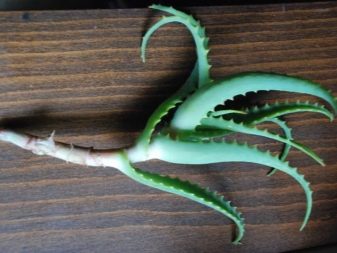
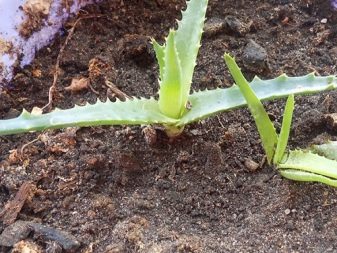
Before planting, the containers should be disinfected: a clay pot is treated with a superphosphate solution, plastic containers are washed with soap (household) and rinsed with hot water, ceramic bowls are thermally treated in the oven for 10-15 minutes.
How to propagate by scions?
Often, an adult aloe grows outgrowths, which are called babies, appendages. They are basal processes with their own autonomous root system. Young babies take food from the mother plant, thereby weakening it. Therefore, it is so important to transplant them. Reproduction by shoots is a natural method that makes it possible to get a young plant immediately.
This method consists in separating the children from the mother's bush and transplanting them into the ground. It allows you to grow several young aloe bushes at once. Usually it is combined with a transplant of the mother bush, so as not to disturb the plant once again.
First, children are selected and separated in the following sequence:
- first of all, you need to moisten the soil well;
- take the pot, tilt it slightly and carefully remove the aloe from it;
- then inspect the root system and find out the level of development of the roots of the children - you need to take shoots with well-developed roots.
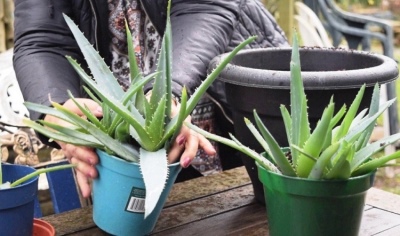
Next, you need to separate the kids. This can be done by hand, gently releasing the roots of the shoots, while being careful not to damage the mother's root system. If this fails, then you have to make cuts with a sharp instrument. Places of cuts must be sprinkled with charcoal powder.
The separated children should be allowed to dry out for several days.
After that, they begin to plant the processes.
- The bottom of the prepared bowl is covered with a layer of drainage, and the soil mixture is poured on top and moistened.
- After 30 minutes after watering, removing excess water, you can plant the appendages. They are deepened into the soil to the lower first leaves (about 1 cm). The soil is slightly compacted.
- For the first 10 days, the scions need to be watered every day. Then watering is reduced. It usually takes about a month to root. Soon, new leaves appear on the young aloe.
Sometimes it happens that a young process breaks off and remains without a root. But even he can regrow the roots.
In this case, such techniques are used as during grafting - they are sprinkled with coal powder, dried for several days, and then planted in the soil.
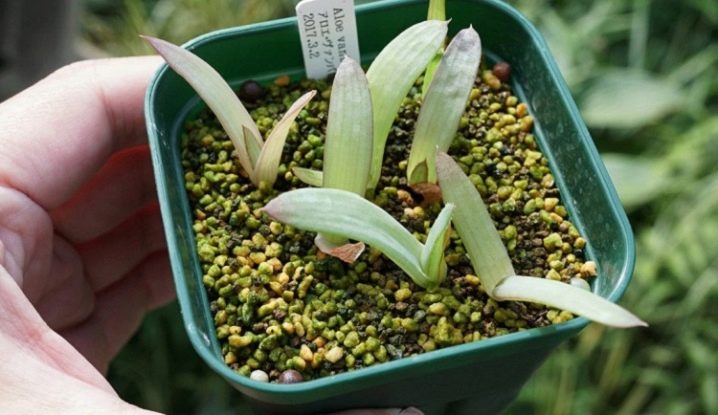
Using the top of the flower
Using the top of aloe for propagation injures the plant, but it is often used to rejuvenate an aged flower, and if its lower leaves and side shoots have already been cut off. This method is simple and easy to perform and leads to the rapid establishment of the apical process.
It is carried out as follows:
- the top must be cut so that there are at least 7 leaves on it;
- the cut off top is dipped in a cut into a solution of phytohormone growth or other root growth stimulator and kept for 30 minutes;
- then the treated process is placed in a glass container with warm (but not hot) water;
- soon the first roots appear, and after they reach 6 cm, the rooted top is planted in the soil in a separate bowl.
Cut off the top only with a clean, sterile instrument, since the smallest contamination can provoke an infection in the flower. Some growers advise, after cutting off the top, to hold the shoot for several days in a dark room until a protective film forms, and only then put the top in water.
Reproduction by tips has such advantages as accessibility to even the most inexperienced growers and the ability to observe the growth of roots.
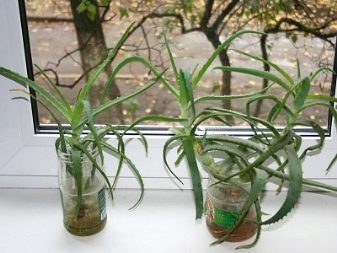
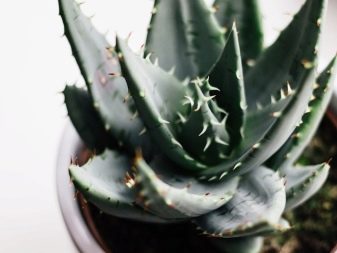
Further care
After planting rooted seedlings in the soil, they must be properly looked after. Despite the fact that aloe is a rather unpretentious plant, it requires some care.
Aloe planted in a bowl must first be placed in a cool room, where direct sunlight does not reach. After a while, the flower can be placed in a sunny place. However, sunlight should not be direct and very intense, otherwise aloe leaves brighten, losing color saturation.
Aloe thrives and grows best in places located in the south, southwest and southeast.
The flower must be adapted to sunlight by placing it in fresh air and gradually increasing the time spent outside.
In winter, it is useful to provide it with additional lighting.
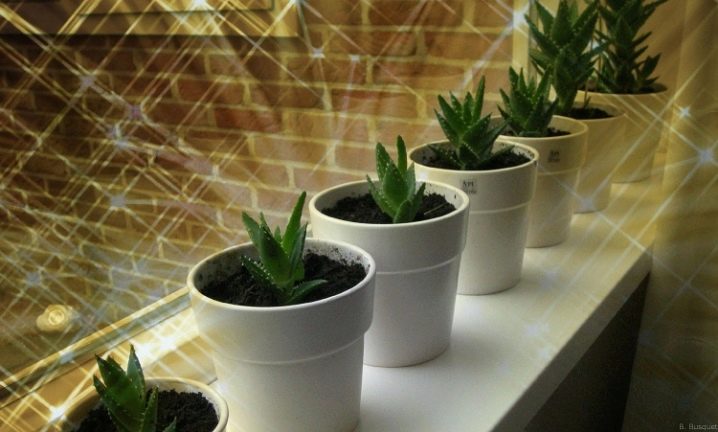
Watering can be done only after the top layer of the soil dries up. The water should settle for several days. Aloe tolerates lack of moisture better than excess. However, during drought, its leaves curl up and dry.
In the summer, in hot weather, watering is required 1-2 times every 7 days, and in the winter months, you can limit yourself to two waterings per month. Do not allow liquid to accumulate in the outlets.
Experienced flower growers use the method of watering through drainage holes: a bowl with a flower is placed in water for 10 minutes, and the plant itself will take the required amount of water.
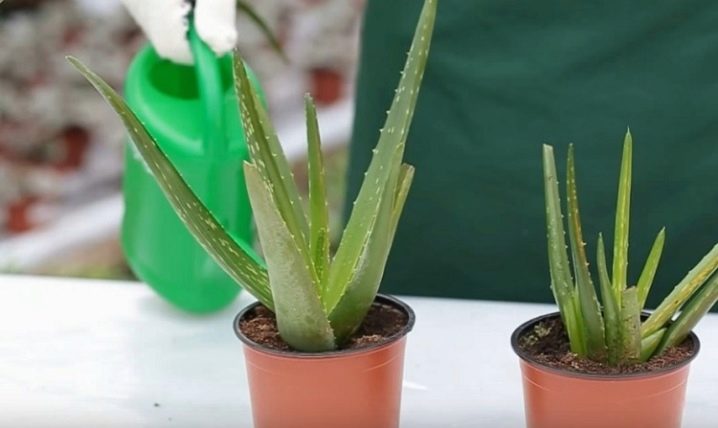
- Temperature regime indoors in summer it should be +20.21 degrees, and in winter - at least +14 degrees Celsius.
- For aloe aeration you need to periodically ventilate the room. But hypothermia of the plant should not be allowed, and also aloe does not tolerate drafts.
- When dust appears on the leaves they must be wiped with a wet cloth. It is not recommended to spray the flower.
- It is necessary to regularly examine the flower in order to detect signs of disease or the presence of harmful insects. If aphids or scale insects appear, the plant should be sprayed with garlic tincture or wiped with a cotton swab moistened with alcohol.
- To maintain the growth and development of the flower, from time to time need to be fed. Top dressing is not done for about 9 months if the seedling was planted in succulent soil, since it contains all the necessary nutrients.
It must be remembered that you cannot fertilize a young flower in winter when the plant is dormant.

And also you can not apply fertilizers immediately after planting - you can harm the roots. It is recommended to apply fertilizer solutions through a pallet - this way there is no risk of excess. Top dressing is applied after watering. Most often, complex fertilizers are used for succulents.
It is recommended to replant only young (up to 5 years old) flowers annually. From the age of five, it is carried out after 3 years. It is recommended to replant only in spring and summer.
Sometimes rooted and planted aloe seedlings do not take root. There can be several reasons for this phenomenon.
- The use of low-quality ready-made soil. In this case, shoots taken from an unhealthy plant may not take root and soon die.
- Incorrect soil composition. It is urgent to transplant the aloe into a properly formulated substrate or ready-made soil for succulents.
- Violation of the rules of care. Most often this is waterlogging of the soil. In this case, you should dry the soil in the pot, and only then resume watering.
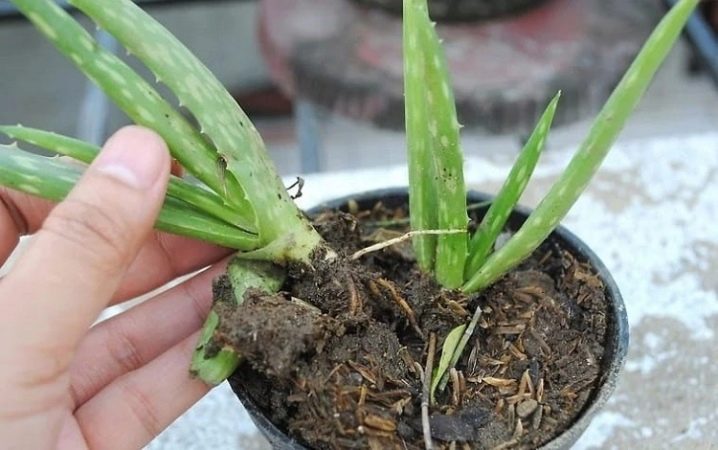
When growing aloe, the following problems may arise:
- with a lack of light aloe stretches, and the leaves become smaller;
- with an abundance of sun leaves become wrinkled, and their color takes on a red tint;
- a yellow border around the edge of the sheet plate and dried tips may occur due to the chlorine content of tap water, or if the flower is deficient in potassium.
When growing young aloe, it must be remembered that the flower does not tolerate sudden changes in conditions.
It is also not recommended to place a flower next to heating devices - this can lead to decay of its root system.
You can learn how to transplant aloe from the following video.























































The comment was sent successfully.